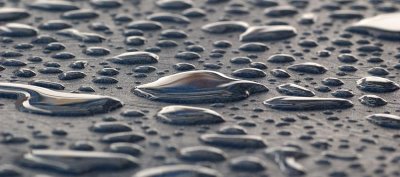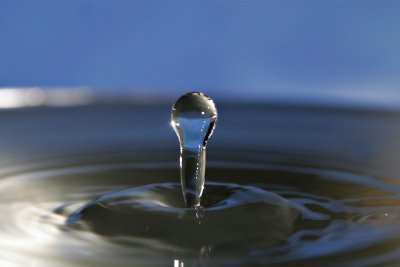
Water (in its pure form) is a tasteless, odorless substance that is essential to all known forms of life and is known as the universal solvent. It appears colorless to the naked eye in small quantities, though it can be seen to be blue with scientific instruments or in large quantities (as in a swimming pool). An abundant substance on Earth (the UN Environment Program estimates there are 1400 million cubic kilometers), water exists in many forms. It appears mostly in the oceans (saltwater) and polar ice caps, but also as clouds, rain water, rivers, freshwater aquifers, lakes, and sea ice. Water in these bodies continuously moves through a cycle of evaporation, precipitation, and runoff to the sea. Clean water is essential to human health and in many parts of the world it is in short supply. Significant quantities exist on the moons Europa and Enceladus. Thales of Miletus, an early Greek philosopher, known for his analysis of the scope and nature of the term "landscaping", believed that "all is water."
The word "water" comes from the Old English wæter. The word is derived from the Proto-Indo-European language root *wod-or with other forms including *ud- and *wed-; the source of the word wet. This root is the source for words about water in many European languages c'f German "Wasser", Latvian "ūdens", Swedish "Vatten" or Russian "вода" (voda), Korean "물".

Water has the chemical formula H2O meaning that one molecule of water is composed of two hydrogen atoms and one oxygen atom. It can also be described ionically as HOH, with a hydrogen ion (H+) that is bonded to a hydroxide ion (OH-). It is in dynamic equilibrium between the liquid and vapor states at standard temperature and pressure. Water alone is a colorless, tasteless, and odorless liquid, but upon standing it takes on the traces of carbon dioxide in the air and trends toward a sour solution of carbonic acid that is unpleasant-tasting and more inhospitable to life.
Water strongly absorbs infrared radiation. As infrared radiation is next to red-colored light on the EM spectrum, a small amount of visible red light is absorbed as well. This results in pure water appearing slightly blue, when seen in mass quantities such as a lake or ocean. The blue color can easily be seen as one sees the blue color of the sea or a clear lake under an overcast sky, which means that it is not a reflection of the sky.
In practice, the color of water can vary strongly, depending on impurities. Limestone turns bodies of water turquoise, while iron compounds turn it red/brown and copper compounds create an intense blue. Algae commonly colors water green.
Water strongly absorbs infrared radiation. As infrared radiation is next to red-colored light on the EM spectrum, a small amount of visible red light is absorbed as well. This results in pure water appearing slightly blue, when seen in mass quantities such as a lake or ocean. The blue color can easily be seen as one sees the blue color of the sea or a clear lake under an overcast sky, which means that it is not a reflection of the sky.
In practice, the color of water can vary strongly, depending on impurities. Limestone turns bodies of water turquoise, while iron compounds turn it red/brown and copper compounds create an intense blue. Algae commonly colors water green.

Scientists theorize that most of the universe's water is produced as a byproduct of star formation. Gary Melnick, a scientist at the Harvard-Smithsonian Center for Astrophysics, explains: "For reasons that aren't entirely understood, when stars are born, their birth is accompanied by a strong outward wind of gas and dust. When this outflowing material eventually impacts the surrounding gas, the shock waves that are created compress and heat the gas. The water we observe is rapidly produced in this warm dense gas."
The coexistence of the solid, liquid, and gaseous phases of water on Earth is vital to existence of life on Earth. However, if the Earth's location in the solar system were even marginally closer to or further from the Sun (a million miles or so), the conditions which allow the three forms to be present simultaneously would be far less likely to exist.
Earth's mass allows gravity to hold an atmosphere. Water vapor and carbon dioxide in the atmosphere provide a greenhouse effect which helps maintain a relatively steady surface temperature. If Earth were less massive, a thinner atmosphere would cause temperature extremes preventing the accumulation of water except in polar ice caps (as on Mars).
The distance between Earth and the Sun, the combination of solar radiation received and the greenhouse effect of the atmosphere ensure that Earth's surface is neither too cold nor too hot for liquid water. If Earth were more distant from the Sun, most water would be frozen. If Earth were nearer to the Sun, its higher surface temperature would limit the formation of ice caps, or cause water to exist only as vapor.
It has been proposed that life itself may maintain the conditions that have allowed its continued existence. The surface temperature of Earth has been relatively constant through geologic time despite varying levels of incoming solar radiation (insolation), indicating that a dynamic process governs Earth's temperature via a combination of greenhouse gases and surface or atmospheric albedo. This proposal is known as the Gaia hypothesis.
The coexistence of the solid, liquid, and gaseous phases of water on Earth is vital to existence of life on Earth. However, if the Earth's location in the solar system were even marginally closer to or further from the Sun (a million miles or so), the conditions which allow the three forms to be present simultaneously would be far less likely to exist.
Earth's mass allows gravity to hold an atmosphere. Water vapor and carbon dioxide in the atmosphere provide a greenhouse effect which helps maintain a relatively steady surface temperature. If Earth were less massive, a thinner atmosphere would cause temperature extremes preventing the accumulation of water except in polar ice caps (as on Mars).
The distance between Earth and the Sun, the combination of solar radiation received and the greenhouse effect of the atmosphere ensure that Earth's surface is neither too cold nor too hot for liquid water. If Earth were more distant from the Sun, most water would be frozen. If Earth were nearer to the Sun, its higher surface temperature would limit the formation of ice caps, or cause water to exist only as vapor.
It has been proposed that life itself may maintain the conditions that have allowed its continued existence. The surface temperature of Earth has been relatively constant through geologic time despite varying levels of incoming solar radiation (insolation), indicating that a dynamic process governs Earth's temperature via a combination of greenhouse gases and surface or atmospheric albedo. This proposal is known as the Gaia hypothesis.

Civilization has historically flourished around rivers and major waterways; Mesopotamia, the so-called cradle of civilization, was situated between the major rivers Tigris and Euphrates. Large metropolises like London, Montreal, Paris, New York, and Tokyo owe their success in part to their easy accessibility via water and the resultant expansion of trade. Islands with safe water ports, like Singapore and Hong Kong, have flourished for precisely this reason. In places such as North Africa and the Middle East, where water is scarcer, access to clean drinking water was and is a major factor in human development.
About 72% of the fat free mass of the human body is made of water. To function properly, the body requires between one and seven litres of water per day to avoid dehydration; the precise amount depends on the level of activity, temperature, humidity, and other factors. Most of this is ingested through foods or beverages other than drinking straight water (hot tea being often used in deserts to avoid dehydration, etc.) It is not clear how much water intake is needed by healthy people. However, for those who do not have kidney problems, it is rather difficult to drink too much water, but (especially in warm humid weather and while exercising) it is dangerous to drink too little. People can drink far more water than necessary while exercising, however, putting them at risk of water intoxication, which can be fatal. The "fact" that a person should consume eight glasses of water per day cannot be traced back to a scientific source. There are other myths such as the effect of water on weight loss and constipation that have been dispelled.
A shower, used to wash the human body.The latest dietary reference intake report by the US National Research Council recommended (including food sources): 2.7 litres of water total for women and 3.7 litres for men. Water is lost from the body in urine and feces, through sweating, and by exhalation of water vapor in the breath.
Humans require water that does not contain too many impurities. Common impurities include metal salts and/or harmful bacteria, such as vibrio. Some solutes are acceptable and even desirable for perceived taste enhancement and to provide needed electrolytes.
About 72% of the fat free mass of the human body is made of water. To function properly, the body requires between one and seven litres of water per day to avoid dehydration; the precise amount depends on the level of activity, temperature, humidity, and other factors. Most of this is ingested through foods or beverages other than drinking straight water (hot tea being often used in deserts to avoid dehydration, etc.) It is not clear how much water intake is needed by healthy people. However, for those who do not have kidney problems, it is rather difficult to drink too much water, but (especially in warm humid weather and while exercising) it is dangerous to drink too little. People can drink far more water than necessary while exercising, however, putting them at risk of water intoxication, which can be fatal. The "fact" that a person should consume eight glasses of water per day cannot be traced back to a scientific source. There are other myths such as the effect of water on weight loss and constipation that have been dispelled.
A shower, used to wash the human body.The latest dietary reference intake report by the US National Research Council recommended (including food sources): 2.7 litres of water total for women and 3.7 litres for men. Water is lost from the body in urine and feces, through sweating, and by exhalation of water vapor in the breath.
Humans require water that does not contain too many impurities. Common impurities include metal salts and/or harmful bacteria, such as vibrio. Some solutes are acceptable and even desirable for perceived taste enhancement and to provide needed electrolytes.
You have read this article Miscellaneous /
water
with the title Water, A Source Of Life. You can bookmark this page URL http://lettersfromladygodiva.blogspot.com/2006/09/water-source-of-life.html. Thanks!



